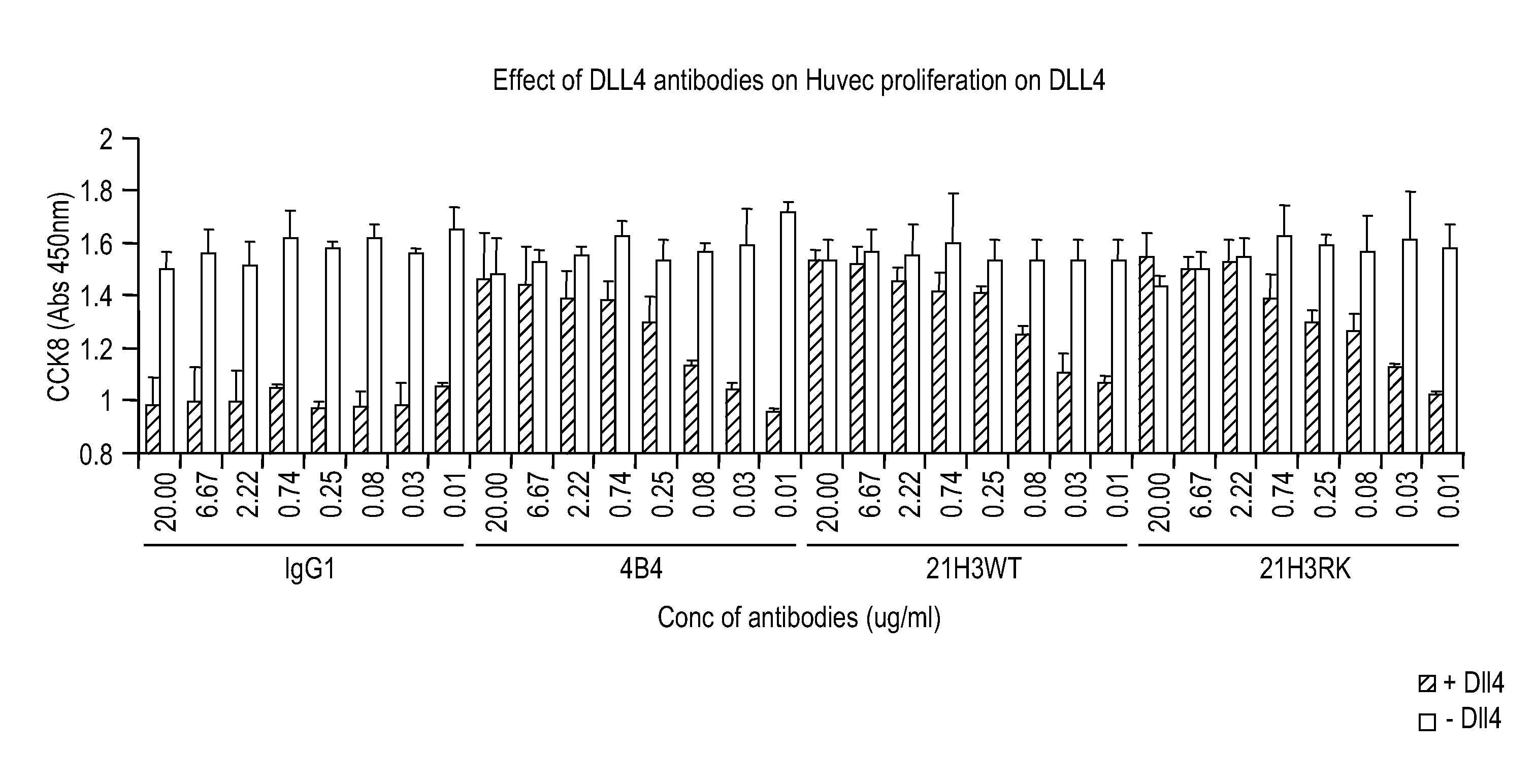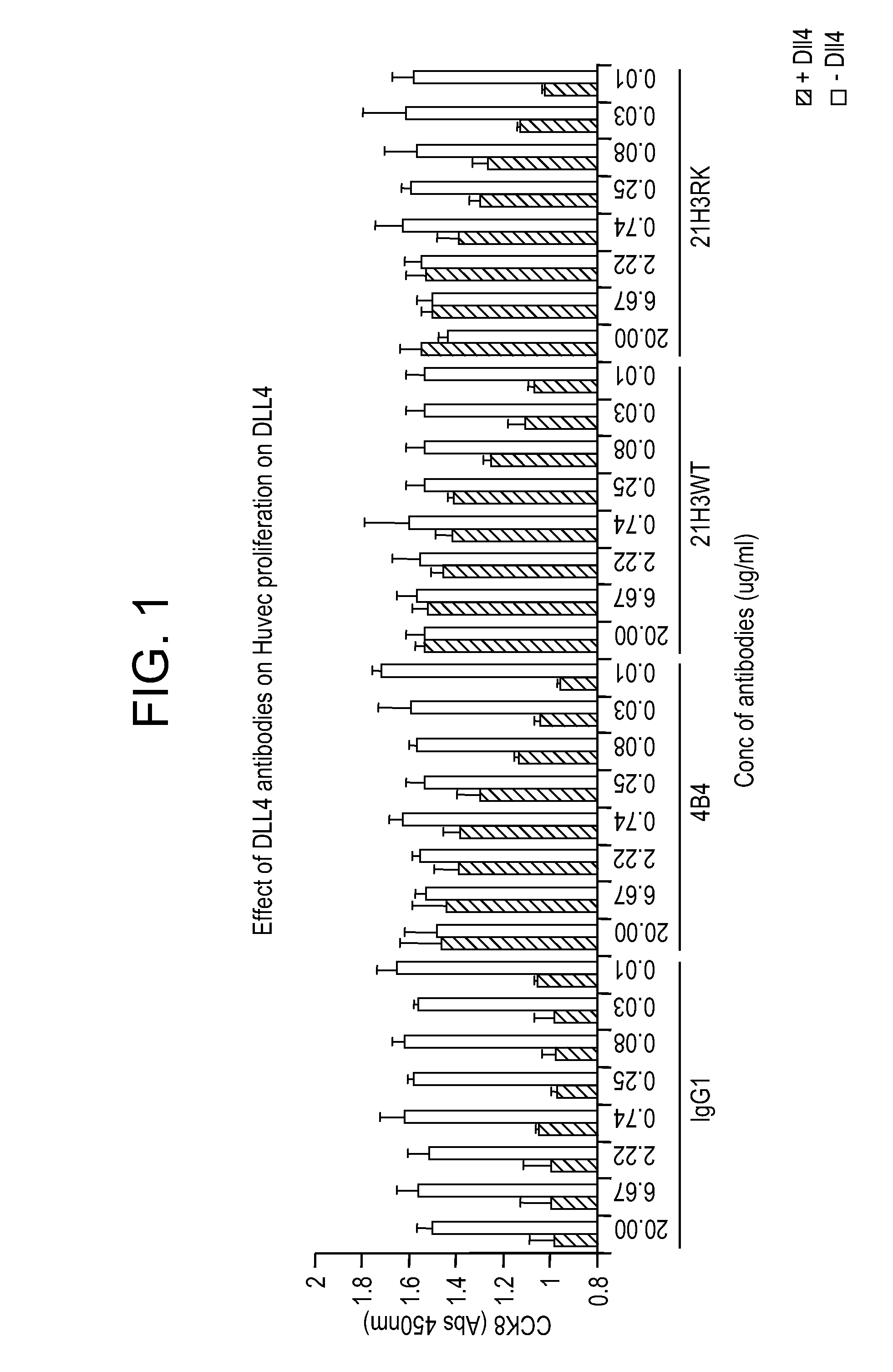Targeted binding agents directed to dll4 and uses thereof 524
a technology of dll4 and binding agent, applied in the direction of antibacterial agents, drug compositions, antibacterial ingredients, etc., can solve the problems of increasing the density of poorly functional vessels in tumors, vascular abnormalities in embryonic lethality, and vascular abnormalities in severe lethality. , to achieve the effect of enhancing the ability of activating effector cells, and enhancing the ability of fixing complemen
- Summary
- Abstract
- Description
- Claims
- Application Information
AI Technical Summary
Benefits of technology
Problems solved by technology
Method used
Image
Examples
example 1
Immunization and Titering
Immunogens
[0334]The extracellular domain of human DLL4 (amino acids 1-524) and recombinant human DLL4 transiently expressed in Chinese Hamster Ovary (CHO) cells were used as antigens for immunizations. For the generation of the CHO transfectants, human full length DLL4 cDNA (Yoneya et al., 2001, J. Biochem., 129, 27-34) was inserted into pcDNA3.1 vector and lipofected into CHO cells (American Type Tissue Collection, catalog # CCL-61). Expression of human DLL4 at the cell surface at the level suitable for the purpose of immunization was confirmed by fluorescent activated cell sorting (FACS) analysis. The extracellular domain of human DLL4 was subcloned from full length DLL4 using the forward 5′-AAGCTGGCTAGCGCGAATGGCGGCAGCGTCCCGGAG and reverse 5′-CAGCCTCGAGCGGCCGCCCAGGGGAAGCTGGGCGGCAAGC primers. The PCR product was purified and ligated into the pSecTag expression vector from Invitrogen. The clone was subsequently transfected into 293T cells using 293fectin tra...
example 2
Recovery of Lymphocytes, B-Cell Isolations, Fusions and Generation of Hybridomas
[0337]Immunized mice were sacrificed by cervical dislocation and the draining lymph nodes were harvested and pooled from each cohort. The lymphoid cells were dissociated by grinding in DMEM to release the cells from the tissues, and the cells were suspended in DMEM. B cells were enriched by positive selection using CD19 labelled Dynal beads. A fusion was performed by mixing washed enriched B cells from above and nonsecretory myeloma P3X63Ag8.653 cells purchased from ATCC (catalog #CRL 1580) (Kearney et al., J. Immunol. 123, 1979, 1548-1550) at a ratio of 1:1. The cell mixture was gently pelleted by centrifugation at 800×g. After complete removal of the supernatant, the cells were treated with 2-4 ml of Pronase solution (CalBiochem, catalog #53702; 0.5 mg / ml in PBS) for no more than 2 minutes. Then 3-5 ml of FBS was added to stop the enzyme activity and the suspension was adjusted to 40 ml total volume us...
example 3
Binding to Cell Bound Human and Cynomolgus Monkey DLL4 and Human Jagged1
[0338]Supernatants collected from harvested cells were tested to assess the ability of the secreted antibodies to bind to 293T cells transiently overexpressing either full length human or cynomolgus monkey DLL4 or human Jagged1. A mock-transfected 293T cell line was used as a negative control. Cells diluted in PBS containing 2% FBS were seeded at a density of 3000 expressing and 15000 mock transfected cells per well in 384 well plates (Corning Costar, catalog #3712). Immediately after plating, 15 or 20 μl / well of hybridoma supernatants and 10 μl / well of secondary antibody (Goat anti-human IgG Fc Cy5, final concentration 750 ng / ml) were added and plates incubated for 3 h at room temperature prior to reading the fluorescence on the FMAT 8200 instrument (Applied Biosystems). The binding of human Notch1 / Fc chimera (R&D systems, catalog #3647-TK), diluted 1:2 from 2.86 μg / ml was used as a positive control for DLL4 an...
PUM
| Property | Measurement | Unit |
|---|---|---|
| Fraction | aaaaa | aaaaa |
| Fraction | aaaaa | aaaaa |
| Time | aaaaa | aaaaa |
Abstract
Description
Claims
Application Information
 Login to View More
Login to View More - R&D
- Intellectual Property
- Life Sciences
- Materials
- Tech Scout
- Unparalleled Data Quality
- Higher Quality Content
- 60% Fewer Hallucinations
Browse by: Latest US Patents, China's latest patents, Technical Efficacy Thesaurus, Application Domain, Technology Topic, Popular Technical Reports.
© 2025 PatSnap. All rights reserved.Legal|Privacy policy|Modern Slavery Act Transparency Statement|Sitemap|About US| Contact US: help@patsnap.com



